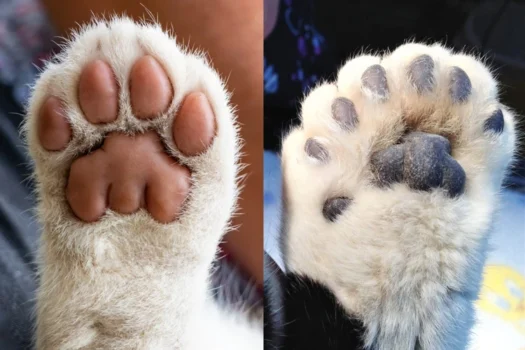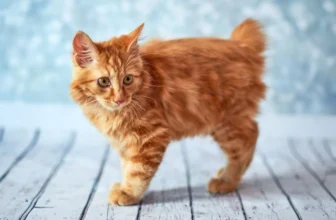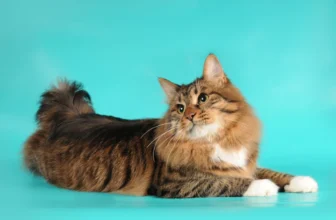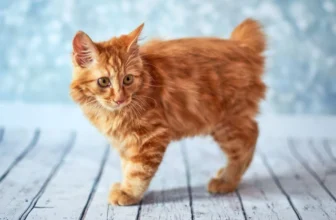Have you ever come across a cat with extra toes on its paws? Well, you might be witnessing a fascinating genetic anomaly known as polydactylism. American Bobtails, a popular breed of cats, are known to often exhibit this trait. If you’re curious about polydactylism in American Bobtails, you’ve come to the right place. In this guide, we’ll delve into the role of polydactylism in American Bobtail’s paws with a comprehensive breakdown of the health and behavioral effects of this fascinating genetic trait. So sit back, grab a cup of coffee, and let’s dive in.
Understanding Polydactylism in American Bobtail

Polydactylism in cats has always been a fascinating subject for cat lovers, and American Bobtails are no exception. This breed is known for its muscular build, unique coat patterns, and striking eyes. However, one of its most distinctive features is its polydactyl paws. Understanding what polydactylism is and how it affects American Bobtails is important for cat enthusiasts and breeders. In this article, we will delve into the world of polydactylism in American Bobtails and explore its effects on their health, behavior, and breed standards. But first, let us discuss what polydactylism really means.
What is Polydactylism?
Polydactylism is a genetic anomaly that results in cats having more than the usual number of toes on one or more paws. It is also known as hyperdactylism. In cats, the polydactylism trait is usually passed down to them from their parents or ancestors. This phenomenon is more common in certain cat breeds, including the American Bobtail. A normal cat has five toes on the front paws and four toes on the back paws, but in some cases, cats with polydactylism may have up to 7 toes, with even more rare cases having up to 9 toes on one paw. Polydactylism is not a disease or a health problem affecting felines, but rather is a physical trait caused by a genetic mutation.
Polydactylism can be seen in various animal species, but it is most commonly observed in cats. This condition is not harmful to a cat’s health but can sometimes create mobility issues for some cats. Cats with polydactyly have bigger, wider paws, and sometimes the extra toes get in their way when they try to walk or groom themselves. However, this is not the case for all cats that have the condition. In fact, some polydactyl cats have been noted to be exceptional climbers and hunters, possibly due to their added toes allowing them more traction on slippery surfaces, and greater stability when jumping.
It is essential to note that polydactylism is different from having a disformed foot or an extra growth. In some cases, random mutations or injuries can cause toes or other appendages to grow on a cat’s paws, but this is not the same as polydactylism. Mutated or disformed toes can result in difficulty walking, pain, or other health problems, whereas polydactylism does not have any negative health risks.
In short, polydactylism is a common genetic trait in cats, and American Bobtails, in particular, are known for having it. Although it doesn’t pose any health concerns, it can moderately affect a cat’s mobility, visibility, and ability to groom effectively. However, it does not hinder a cat’s life or survival. In the next section, we will explore the relationship between polydactylism and an American Bobtail’s health and behavior.
To learn more about the unique physical characteristics of American Bobtails, check out this informative article on /american-bobtail-muscular-build/.
Polydactylism in American Bobtail
Polydactylism in American Bobtail refers to a genetic trait that makes them have extra toes on their paws. Unlike other cats, American Bobtail cats have a significant number of extra toes which create a unique feature recognizable from other breeds. This unique feature is believed to have originated from the breed’s wildcat ancestors in the 1960s. The extra toes on their paws are usually functional and help them perform their daily activities, such as catching prey, climbing, and running.
Polydactyl American Bobtails have unique qualities that make them distinctive and lovable. Their extra toes provide them with added stability, balance, and power which enables them to conduct various activities effortlessly. These extra toes also allow them to dig effectively, which comes in handy when they want to bury food or cover their waste. It is fascinating to know that some American Bobtail owners consider the number of extra toes a significant factor when choosing a cat. They believe that the higher the number of extra toes, the more unique and attractive their cat is.
However, it’s essential to know that Polydactyl American Bobtails may face some challenges with their paws that non-polydactyl cats don’t encounter. For example, their extra toes might attract dirt and other unwanted substances, which may lead to infections. Additionally, their extra toes may affect their ability to wear normal sized shoes, which in turn may result in arthritis or other foot-related diseases. It’s critical for cat owners to be aware of these potential issues and ensure that their pet’s hygiene is top-notch.
Polydactylism in American Bobtail is a unique feature that makes the breed stand out. Their extra toes provide them with added functionality, and it’s no surprise that cat lovers find the breed irresistible. However, it’s vital to be cognizant of the potential paw-related challenges they may encounter and take appropriate measures to ensure their health and overall well-being.
The Relation of Polydactylism to American Bobtail’s Health and Behavior

When it comes to the American Bobtail breed, polydactylism is one unique trait that sets them apart from other felines. But what is the relation of polydactylism to their health and behavior? Many pet owners and breeders are intrigued by how this extra toe can affect their beloved pet’s life. In this section, we’ll explore the positive and negative effects of polydactylism on American Bobtail’s health, as well as the behavioral traits that come along with it. We’ll also discuss the ongoing debate on whether this trait should be accepted as part of the breed standard. To learn more about other distinguishing characteristics of the American Bobtail, check out our article on unique coat patterns, short tails, powerful legs, body shape and health, and striking eyes.
Positive Effects of Polydactylism on Health
Polydactylism in American Bobtail paws is often viewed as a unique genetic trait of the breed, and it comes with a range of both positive and negative effects. In terms of health, there are several benefits associated with polydactylism in American Bobtail cats.
One of the most significant positive effects of polydactylism is that it may lead to improved balance and agility in the cats. The extra toes on their paws provide additional support for the cat’s body, which can help them walk, run, and jump with greater ease. Their paws are also wider than normal, which adds stability and improves their grip.
Another beneficial effect of polydactylism in American Bobtails is that it can reduce the likelihood of certain foot injuries. The additional toes act as a cushion, reducing the risk of impact when they jump or land from high places. The wider paws also provide a larger surface area for absorbing shocks from falls.
Additionally, polydactylism can lead to improved hunting abilities. The extra toes on their paws provide a larger surface area for grasping prey, making hunting more effective. Some studies have shown that polydactyl cats tend to be better hunters than those with a normal number of toes.
While there are some negative aspects of polydactylism, it is important to acknowledge the potential benefits of this genetic trait in American Bobtails. The following table summarizes some of the positive effects of polydactylism on the health of these cats:
| Positive Effects of Polydactylism on Health |
|---|
| Improved balance and agility due to additional support |
| Reduced likelihood of foot injuries due to additional cushioning |
| Improved hunting abilities due to larger surface area for grasping prey |
It is important to note that while polydactylism can provide these benefits, it is not a requirement for a healthy American Bobtail. It is simply a unique genetic trait that has both positive and negative effects, and should not be the only factor considered when choosing a cat.
Negative Effects of Polydactylism on Health
While there are several positive aspects of polydactylism in American Bobtails, it’s also worth noting some of the negative effects it may cause in terms of their health. Here are some of the potential drawbacks of polydactylism in American Bobtail cats:
| Health Issues | Description |
|---|---|
| Painful Claw Problems | Having extra toes can lead to problems with the claws. They can grow abnormally and may need regular trimming. In some cases, the extra toes can put pressure on the pads of the feet, leading to pain and discomfort. |
| Joint Problems | Extra toes can affect the alignment of the bones in the paws, leading to potential joint problems. This can cause immobility, deformities and chronic pain. |
| Developmental Abnormalities | Having extra toes can lead to developmental abnormalities in the growth of the paws and feet, causing them to be misshapen or deformed. They can also suffer from diminished stability, posture and gait issues. |
| Infections | Extra toes may also cause issues in terms of grooming and maintaining proper hygiene, making it more difficult for cats to keep their paws clean. This can lead to skin irritations or infections, often causing discomfort and distress for the animal. |
| Difficulty Finding Suitable Homes | Unfortunately, many potential pet owners may not be interested in adopting a polydactyl American Bobtail because of the potential health complications associated with their extra toes. This can lead to difficulties in finding loving homes for these cats due to more specific needs and additional medical costs. |
While these negative effects shouldn’t be taken lightly, it’s worth noting that not every polydactyl American Bobtail will experience these issues, and in many cases, any problems that do arise can be effectively managed with proper care and attention.
Behavioral Traits of Polydactyl American Bobtails
Polydactyl American Bobtails are not only unique in physical traits, but also in behavioral traits. While there is no significant difference in personality between polydactyl and non-polydactyl Bobtails, there are a few behavioral traits that have been noted in some cats with extra toes. Let’s take a closer look at some of these traits in the table below:
| Behavioral Traits | Description |
|---|---|
| Playfulness | Polydactyl American Bobtails are playful cats and enjoy playing with their owners or by themselves. They have a lot of energy and are always up for playing with toys or chasing after a laser pointer. |
| Curiosity | These cats are naturally curious and enjoy exploring new environments. They will often investigate new objects or areas, and may even climb to high places to get a better view. |
| Intelligence | Polydactyl American Bobtails are highly intelligent cats and enjoy figuring out puzzles or challenges. They are known for their problem-solving skills, and can quickly learn new tricks or commands. |
| Loyalty | These cats are known to be highly loyal to their owners and enjoy spending time with them. They will often follow their owners around the house and may even try to “help” with various activities or chores. |
| Sociability | Polydactyl American Bobtails are sociable cats and enjoy spending time with people or other pets. They are not usually shy or reserved, and will often greet guests with a friendly meow and a rub against their legs. |
It’s important to note that not all polydactyl American Bobtails will exhibit these traits, as personality can vary between individual cats. However, these common behavioral traits are certainly appealing to owners who are looking for an active, intelligent, and sociable feline companion.
The Debate on Polydactylism and Breed Standards
As the discussion about polydactylism among American Bobtails continues, it naturally turns its focus on the breed’s standards. It’s a topic that sparks intense debate among experts, enthusiasts, and breeders alike. What is the controversy surrounding the role of polydactylism in American Bobtails’ breed standards, and how did it come to be? These questions lead to an engrossing and sometimes contentious discussion that shines a light on the complexities of breeding cats and the need to balance genetic diversity with breed conformity.
History of Polydactylism in American Bobtail
The history of polydactylism in American Bobtail is fascinating and discussed by many experts in the field. Here are some important points to keep in mind about the subject:
- Polydactylism was initially common in cats. For a long time, polydactyl cats were not considered abnormal but rather seen as unique and even desirable. Records suggest that these cats were even kept as “ship cats” in the past, as their extra toes were thought to offer better balance and handling on board.
- Native American involvement. American Bobtails were bred in the 1960s, and it is speculated that polydactylism in these cats is due to the involvement of indigenous peoples, who had bred polydactyl cats for centuries.
- A genetic mutation caused polydactylism in American Bobtail. While the exact cause of polydactylism in American Bobtail is unclear, genetic factors may be at play. There are several types of polydactylism, and American Bobtails exhibit a form called preaxial polydactylism, in which extra toes grow on the cat’s forelimbs.
- Reintroduction of polydactylism in the breed. For a period, the breed was discouraged from exhibiting polydactylism due to breed standards set by major cat organizations. However, in recent years, there has been a resurgence of interest in the trait, and breeders advocate for its preservation.
The history of polydactylism in American Bobtail is complex and fascinating, with many factors at play. As the breed continues to evolve and develop, it will be interesting to see how the role of polydactylism is perceived and how it fits into evolving breed standards.
The Controversy on Polydactyl American Bobtails
Polydactylism in American Bobtail cats has been a subject of intense debate in the cat breeding community. Some breeders believe that the extra toes enhance the breed’s natural abilities, while others argue that it detracts from the breed standards.
The Pro-Polydactyl Argument
Proponents of polydactyl cats claim that their extra toes provide them with better balance, dexterity, and grip. These traits could be especially useful for an outdoor cat like the American Bobtail, which were originally bred for their hunting abilities. Some breeders believe that the extra toes give the breed a unique and recognizable appearance.
The Anti-Polydactyl Argument
On the other hand, many breeders and organizations contend that polydactyl cats should not be bred or shown because they do not conform to breed standards. The Cat Fanciers’ Association, the world’s largest registry of purebred cats, does not recognize the American Bobtail with more than the standard number of toes. They argue that polydactylism detracts from the breed’s overall appearance and may be associated with other genetic abnormalities.
The Ethical Argument
The controversy surrounding polydactyl American Bobtails extends beyond aesthetics and breed standards. Some animal welfare advocates argue that breeding cats with extra toes is unethical because it can lead to health problems. They believe that breeding cats for a physical trait that is not essential to their well-being is a frivolous and unscrupulous practice.
The debate surrounding polydactyl American Bobtails is complex and multifaceted. While some breeders believe that the extra toes are beneficial for the breed, there are concerns about their impact on health and genetic diversity. Ultimately, the decision to breed polydactyl American Bobtails should be made responsibly and with consideration for the welfare of the animal.
| Pros | Cons | Ethical Concerns |
|---|---|---|
| Provides better balance, dexterity, and grip | Does not conform to breed standards | Can lead to health problems |
| May enhance hunting abilities | May detract from breed’s overall appearance | Breeding for a physical trait that is not essential |
| Increase breed’s uniqueness and recognizability | May be associated with other genetic abnormalities |
International Breed Standards for American Bobtail
When it comes to breed standards for American Bobtail, there are certain rules that are followed by various organizations around the world. These organizations specify what features must be present to classify a cat as an American Bobtail. Here is a breakdown of the breed standards for American Bobtail set by international organizations:
| Organization | Breed Standards |
|---|---|
| The International Cat Association (TICA) | American Bobtails must have a sturdy, muscular body with a naturally bobbed tail that can be straight or slightly curved. They should have an alert expression, with large, wide-set eyes, and a broad, modified wedge-shaped head. The ears should be medium to large in size and slightly rounded at the tips. |
| The Cat Fanciers Association (CFA) | The CFA breed standard for American Bobtails is similar to TICA. The body should be medium to large, with a naturally bobbed tail that can be anywhere from one to four inches long. The head should be broad with a squared jaw and strong chin. The ears should be moderately large, with a slight outward tilt. |
| International Cat Federation (FIFe) | The FIFe breed standard places emphasis on the cat’s bobbed tail. According to FIFe, the tail should be “visible, apparent, and not adjustable.” They should also have a strong, sturdy body with a broad chest and wide-set legs. The head should be medium in size with a rounded forehead and a distinct stop. |
It’s worth noting that while each organization has slight differences in their breed standards, they all agree on the importance of the American Bobtail’s naturally bobbed tail. The shape and length of the tail can also vary slightly depending on the organization.
While polydactylism is not specifically mentioned in the breed standards, it is not considered a disqualifying trait. In fact, some organizations even have separate classes for polydactyl American Bobtails. However, it’s important to note that excessively large or misshapen extra toes would be considered a fault in breed standards.
The international breed standards for American Bobtail highlight the unique features that make this breed stand out. From their sturdy build to their distinctive bobbed tail, American Bobtails are a fascinating and beloved feline breed.
Conclusion
After exploring the role of polydactylism in American Bobtail’s paws, we can conclude that there are both positive and negative effects associated with this genetic variation. While polydactylism can provide some health benefits such as improved balance and agility, it can also lead to certain health issues such as osteoarthritis and skin irritation. Additionally, polydactyl American Bobtails exhibit unique behavioral traits such as increased curiosity and playfulness.
The debate on whether or not to accept polydactyl American Bobtails as a breed standard continues to be a controversial topic in the cat breeding community. Some breeders argue that polydactylism should be accepted and even promoted as a unique characteristic of the American Bobtail breed, while others believe it should be considered a fault and excluded from breed standards.
Ultimately, whether or not a breeder chooses to include polydactylism in their breeding program is a personal decision. However, it is important to prioritize the health and well-being of the cats and only breed from healthy individuals.
In conclusion, polydactylism in American Bobtail’s paws is an interesting genetic variation that adds unique characteristics to the breed. While it has both positive and negative effects on health and behavior, the decision to include polydactylism in breed standards is a complex and controversial issue that should be carefully considered by breeders.
Frequently Asked Questions
What causes Polydactylism in American Bobtail cats?
Polydactylism is a genetic mutation that can occur spontaneously, or it can be passed down from a cat’s parents. It is caused by a dominant gene, which means that if one parent carries it, there is a 50% chance of their offspring inheriting it as well.
Can Polydactyl American Bobtails have more than the usual number of toes?
Yes, some Polydactyl American Bobtails can have up to seven toes on each paw, which is known as a “double paw.”
Do Polydactyl American Bobtails have any health problems?
While Polydactylism itself does not cause any health problems, American Bobtails with extra toes may be more prone to certain conditions, such as arthritis and joint pain.
Do Polydactyl American Bobtails have unique behavioral traits?
Some owners of Polydactyl American Bobtails report that their cats are more playful and energetic than their non-polydactyl counterparts. However, this may vary from cat to cat and cannot be definitively attributed to the presence of extra toes.
Are Polydactyl American Bobtails recognized as a separate breed?
No, Polydactyl American Bobtails are not recognized as a separate breed by major cat breeding organizations. However, some breeders specialize in breeding polydactyl American Bobtails and consider them to be a separate type.
Can Polydactylism be bred out of American Bobtails?
Polydactylism is a dominant trait, which means that it can be difficult to breed out of a population once it has been introduced. However, breeders who do not wish to produce Polydactyl American Bobtails can select for cats without the gene to reduce the incidence of Polydactylism in their breeding programs.
Do all American Bobtails carry the Polydactyl gene?
No, not all American Bobtails carry the Polydactyl gene. Some cats may have the gene but not express it, while others may not have the gene at all.
What is the controversy surrounding Polydactyl American Bobtails?
Some people argue that breeding for Polydactylism in American Bobtails is unethical, as it can lead to health problems and goes against traditional breed standards. Others believe that Polydactylism adds to the unique charm and character of American Bobtails.
Are Polydactyl American Bobtails more popular than non-polydactyls?
There is no clear evidence that polydactyl American Bobtails are more popular than their non-polydactyl counterparts. However, some cat lovers are drawn to the unique appearance of Polydactyl American Bobtails and seek them out specifically.
Should I adopt a Polydactyl American Bobtail?
Deciding to adopt a cat, whether Polydactyl or not, should be based on factors such as your lifestyle, home environment, and personal preferences. If you are considering a Polydactyl American Bobtail, be aware of the potential health risks associated with extra toes and make an informed decision based on your cat’s needs.







